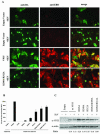Reverse genetic generation of recombinant Zaire Ebola viruses containing disrupted IRF-3 inhibitory domains results in attenuated virus growth in vitro and higher levels of IRF-3 activation without inhibiting viral transcription or replication
- PMID: 16775331
- PMCID: PMC1488969
- DOI: 10.1128/JVI.00044-06
Reverse genetic generation of recombinant Zaire Ebola viruses containing disrupted IRF-3 inhibitory domains results in attenuated virus growth in vitro and higher levels of IRF-3 activation without inhibiting viral transcription or replication
Abstract
The VP35 protein of Zaire Ebola virus is an essential component of the viral RNA polymerase complex and also functions to antagonize the cellular type I interferon (IFN) response by blocking activation of the transcription factor IRF-3. We previously mapped the IRF-3 inhibitory domain within the C terminus of VP35. In the present study, we show that mutations that disrupt the IRF-3 inhibitory function of VP35 do not disrupt viral transcription/replication, suggesting that the two functions of VP35 are separable. Second, using reverse genetics, we successfully recovered recombinant Ebola viruses containing mutations within the IRF-3 inhibitory domain. Importantly, we show that the recombinant viruses were attenuated for growth in cell culture and that they activated IRF-3 and IRF-3-inducible gene expression at levels higher than that for Ebola virus containing wild-type VP35. In the context of Ebola virus pathogenesis, VP35 may function to limit early IFN-beta production and other antiviral signals generated from cells at the primary site of infection, thereby slowing down the host's ability to curb virus replication and induce adaptive immunity.
Figures





References
-
- Baize, S., E. M. Leroy, M. C. Georges-Courbot, M. Capron, J. Lansoud-Soukate, P. Debre, S. P. Fisher-Hoch, J. B. McCormick, and A. J. Georges. 1999. Defective humoral responses and extensive intravascular apoptosis are associated with fatal outcome in Ebola virus-infected patients. Nat. Med. 5:423-426. - PubMed
-
- Becker, S., and E. Muhlberger. 1999. Co- and posttranslational modifications and functions of Marburg virus proteins. Curr. Top. Microbiol. Immunol. 235:23-34. - PubMed
Publication types
MeSH terms
Substances
LinkOut - more resources
Full Text Sources
Medical

